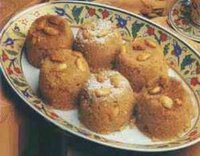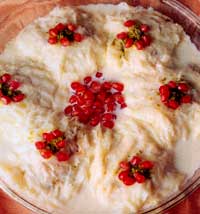Friday, February 24, 2006
Monday, February 20, 2006
TURKISH CUISINE

Nutritional habits are shaped according to the prevalent cultural - geographical - ecological - economic characteristics and features and the historical process.
When one talks about the Turkish cuisine, the term should be understood as the totality of foods and beverages which provide nutrition to the people living in Turkey, the ways of preparing and preserving them; techniques, equipment and utensils required for this, eating manners and all the practices and beliefs which are developed around this cuisine.
The richness of variety Turkish cuisine possesses is due to several factors. In summary, the variety of products offered by the lands of Asia and Anatolia, interaction with numerous different cultures over a long historical process, the new tastes developed in the palace kitchens of the Seljuk and Ottoman empires have all played a part in shaping the new character of our culinary culture.
Turkish Cuisine, which in general consists of sauced dishes prepared with cereals, various vegetables and some meat, soups, cold dishes cooked with olive oil, pastry dishes and dishes made from wild vegetation has also produced a series of health foods such as pekmez, yogurt, bulgur etc. The eating habits which reflect the tastes changing from one location to the next, gains a new meaning and near - sacredness on special occasions, celebrations and ceremonies.
Turkish Cuisine, while rich in variety and taste-bud friendly , also contains examples which could provide a source for healthy and balanced diets and vegetarian cuisines.
MEVLANA'S FEAST
When expounding his philosophy of life, the great Islamic thinker Mevlana choose most of his simbols directly from nature. Foodstuffs also number among those symbols, as is examplifed by the expression, "I was raw, I was cooked, I burned", from his Divan-ı Kebir or Great Divan, a collection of his poems on divine love.
The "kitchen" occupies a very important place in the teachings of Islamic mysticisim, commnonly known as Sufism.For this is the place where the dervishes began their training.
The Sufis, who also place great importance on 'somat' or table manners, take their food twice a day, at noon and in the evening. The dervish novices ('mürid' or 'can') are responsible for setting the table. Salt has ceremonial significance at meals, which begin and end with it.When the preparations are complete, it is time to consume the food. The Kazancı Dede lifts the lid of the 'kazan' or cauldron, and the novices remove it from the fire. The Kazancı Dede's prayer is the invitation to commence eating. Standing with their hands folded in front of them, the Sufis bow their heads in greeting upon arriving at the door and take their places around the table. The meal commences with the arrival of the 'Sheikh' and his prayer. Talking during the meal is strictly forbidden, eating being virtually a from of worship for Mevlevis. As they eat, they give continuous thanks for the morsels set before them. the meal ends in unison, as it began.
*Compotes and Desserts*
Almond Helva

Ingredients:
250 gr butter
2 tbsps blanched almonds
1 cup strong plain flour
1 cup wholemeal flour
3 cups sugar
4 cups water
1 tbsp rose water
Preparation:
Melt the butter in a round-bottomed pan. Add the almonds to the flour and cook on a very low heat, stirringwith a wooden spoon, for approximately 60 minutes, until the almonds and flour have turned golden brown. (A good helva needs to cook for at least 60 minutes.) Put the sugar and water on to heat in a saucepan and stir untill the sugar has dissolved. Remove from the heat two minutes after it has come to a boil and pour on to the cooked flour mixture in its pan and stir. Once it has stopped sticking to the pan, cover and leave on avery low heat for 15 minutes. Spoon the helva into a dish, smoothing the surface with the back of a spoon, sprinkle with rose water and serve hot.
the source : SKYLIFE MAGAZINE
***********
Gullac

Ingredients:
Walnuts (chopped): 1 cup or 100 gr
Sugar: 1 1/3 cup or 240 gr
Milk: 7 1/2 cup or 1.5 kg
Gullac (ready made): 10 piece or 250 gr
Pomegranate: 1/2 small size or 100 gr
Preparation
Combine ground walnuts and 3 tablespoons of sugar. Cut each pastry sheet into half. Scald milk. Add sugar; stir until sugar is dissolved. Dip each pastry sheet in scalded milk. Spoon 1/2 tablespoon of fılling in center. Bring edges together over fılling, making plaits to give rose like effect. Arrange in a serving dish. Pour rest of milk over. Cover and cool. Sprinkle with pomegranate seeds. Chill and serve.
***********
Turkish Buttermilk

Ingredients
Yogurt: 3 1/2 cup or 770 gr
Milk: 2 1/2 cup or 500 gr
Water: 3 cup or 600 gr
Salt: 1 1/2 cup or 9 gr
Preparation
Place yogurt in a bowl. Beat with a fork or a hand mixer until well blended. Add milk gradually, mixing well. Stir in iced cold water. Add salt; mix well. Serve cold.
*****************
BOULETTE AU CUMIN(GRILLE)
500 gr de viande hachée ( 1/3 mouton - 2/3 veau )
2 tranche de mie de pain
3 gousses d'ail
1 petit oignon
½ cuil.thé cumin , ½ cuil. thé de paprika , sel, poivre un peu de l'huile d'olive
Trempez les tranches dans l'eau . Retirez et pressez-les .Emiettez .S'ils sont bien sec , vous pouvez les fariner dans le mixer.
Rapez l'oignon , pilé l'ail , melangez tout . Pétrissez bien au moins 5-6 minutes.
Prenez les morceaux de la taille d'une noix. Faites rouler entre les paumes pour l'arrondir et préssez legerement.
Grillez les boulets sur feu de charbon ( ou dans le four ) Si on veut, on peut préparer une sauce de tomate à l'accompagner


